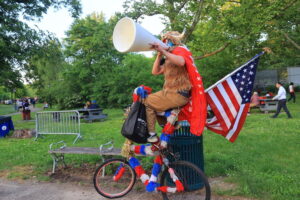If the Trumpian message of decay and decline has any resonance, it’s in places like Hunts Point. Emerging from the subway here in the South Bronx, I see a man on a payphone pleading to speak with a psychotherapist. Another stands outside the entrance begging for change. A third is challenging street vendors to a hand-measuring contest: the winner gets a dollar (no one takes him up on the offer).
This is not Trump country — far from it. But despair in Hunts Point, where almost half of residents live below the poverty line, and where drugs and prostitution are rife, is forcing a rethink. One shopper here stops to tell me why Biden lost her vote. “What did he give me?” Rosaria asks. “My groceries now cost a bomb, my gas is up and I’ve never felt less safe here in my life.” Just a few days ago, she tells me, her son’s best friend got “snatched up” — kidnapped — and they still can’t find him. He was last seen buying a drink inside the local bodega, but nobody has heard from him since. Rosaria believes it could be gang-related. “I don’t want my children outside after dark anymore.”
In this year’s election, 27% of Bronx voters plumped for Trump, almost three times more than in 2016. And in Hunts Point, right at the heart of Alexandria Ocasio-Cortez’s 14th district, the Rightward lurch is even starker. In this neighbourhood, Trump increased his share of votes by 50% compared with four years ago — one of the biggest pro-Trump swings in the country. Nor was this trend unique to the Bronx: Queens, Staten Island and parts of Brooklyn are all becoming redder too. Yet as the electoral post-mortems begin, one big question remains: can New York’s conservative resistance grow?
New York City hasn’t had a Republican mayor since Michael Bloomberg (before he switched allegiances) in 2005, and the state hasn’t voted for a GOP president since 1984. But dissatisfaction with the status quo has been rising since 2020 as crime, the migrant crisis and housing all worsen. No wonder, then, that 573,000 New Yorkers abandoned Harris. While she might have won the city comfortably, securing over twice as many votes as Trump, her margin of victory was 16% lower than Joe Biden’s four years earlier.
For the Republicans, the main challenge here is less the Democrats, and more voter apathy. Of Hunts Point’s 11,000 or so residents, only around 2,774 voted (2,039 for Harris, 735 for Trump). This means that if Rosaria is the face of the GOP’s new coalition — urban, working class and Hispanic — then it is people like her who Republicans need to rally to their side. And while she has reservations about the President-elect (the “Mexico is sending rapists” line still rankles), she says she’s more willing to vote Republican than ever.
Other voters in AOC’s district are more bullish about their support for the President-elect. In the heavily Hispanic neighbourhood of North Corona, a corner of Queens where nearly half of residents went for Trump, a group of Latino barbers explained why they voted red. “Our neighbourhood is a wreck,” says one. “No one is trying to fix anything around here.” Another says that in the past two years, four of his close friends have lost their jobs due to rising costs. He wonders if he’ll be next. One pulls out a phone to show me his two young boys wearing the full MAGA uniform: red cap, red t-shirt and camo trousers. They all went to the President-elect’s rally in the South Bronx. “He came out here to speak to us,” he says. “I’ll never forget that.”
One reason for their discontent muscles out all the others: crime. Like Rosaria, they felt disorder in their neighbourhood was “out of control”. And migrants — North Corona has taken in a big chunk of 200,000 arrivals into the city since 2022 — are getting the blame for the concurrent spike in law-breaking. Yet it was in the Bronx that I saw the city at its worst. As I walked west from AOC’s district into New York’s poorest, a fight broke out by a McDonald’s between two groups of schoolchildren. The brawl was eventually broken up by security, but moments later three undercover police officers escorted a boy in handcuffs to a van. Here was the tale of two Bronxes: rowdy locals scrapping outside of boarded up shops and battered police vans while the new Yankees stadium, which cost some $2.3 billion, loomed behind. The stadium was meant to be a symbol of the borough’s rejuvenation, but it acts, instead, as a constant rebuke.
Certainly, Republicans in New York have increasingly understood the electoral power of disorder. Last year, Trump laid out his “plan to restore law and order”, which he said includes a “record investment in hiring, retention and training” for police officers nationwide and bolstering liability protections for law enforcement. More locally, it formed a core part of Lee Zeldin’s 2021 gubernatorial campaign, where he compared the city’s streets to a “combat zone”. In the end, the Trump loyalist lost to Kathy Hochul, but he nonetheless outperformed expectations — a trend for Republicans in almost every election cycle since Covid. The real test for the GOP, though, will be the mayoral election of 2025. Trump, after all, won’t be on the ballot, meaning that Republican candidates will not be able to ride on his appeal in quite the same way. And already, the odds are heavily stacked against the party. For one thing, the city remains heavily blue, with the number of registered Democrats outnumbering Republicans by around six to one.
At the same time, Harry Siegel explains that the Republican ground operation in New York is basically non-existent. “I am not seeing any sort of serious effort for people outside of the Democratic Party machine to build organisations, structures, and a compelling case to take on the party,” says Siegel, a writer at The City. For that reason, Siegel continues, New Yorkers will once again be left with a choice between the “corrupt centre” and the “crappy progressives”. “There are no serious Republicans throwing their hat into the ring,” he laments. “Those in the running have given no thought to how they would actually run the city.” It’s no wonder that it’s hard to get the vote out.
Yet if a “serious” Republican wanted to run, or an independent like Jim Walden could be persuaded to take the ticket, now would be the time to jump in. Eric Adams, the current mayor, is under investigation for bribery and campaign finance offences, while polls show a majority of New Yorkers want him to resign. If Adams were forced out, or else resigned before the end of his term, that would trigger a special election whereby candidates from any party could challenge the Democrats. It’s a small window of opportunity. But an insurgent candidate campaigning on three key issues — crime, the migrant crisis and housing — could surely energise enough voters and turn those historically low turnouts into a strength.
The 2024 election, after all, was a story not of Republican triumph, but of Democratic passivity. Trump may have added nearly 100,000 votes to his tally from 2020, but over half a million Democrats simply stayed at home. And for those who did vote red, their decision was often deeply personal. Nearly everyone I spoke to said Trump was the first Republican they’d gone for, and many remained loyal Democrats further down the ballot. They don’t see Trump as a Republican, but an outsider, meaning that GOP gains here are by no means guaranteed after the President-elect finally leaves the stage.
New York, then, is for the Democrats to lose. And right now it feels like that’s exactly what’s happening. Between a housing emergency, a migrant crisis, and crime that’s barely back below its Covid peak, fury with the city’s liberal leadership is bubbling over. Those half a million voters who didn’t exercise their democratic right were sending a message to the party. And if they continue to feel ignored, they’re bound to abandon the Democrats. “What more do I have to lose?” Rosaria asked me. In next year’s election, we’ll see if anyone can be bothered to agree.
Disclaimer
Some of the posts we share are controversial and we do not necessarily agree with them in the whole extend. Sometimes we agree with the content or part of it but we do not agree with the narration or language. Nevertheless we find them somehow interesting, valuable and/or informative or we share them, because we strongly believe in freedom of speech, free press and journalism. We strongly encourage you to have a critical approach to all the content, do your own research and analysis to build your own opinion.
We would be glad to have your feedback.
Source: UnHerd Read the original article here: https://unherd.com/



